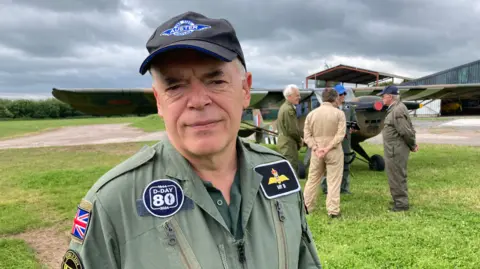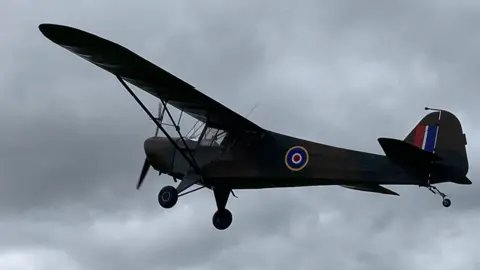Pilots retrace D-Day flight path to Normandy
 BBC
BBCThree men are flying to France in vintage World War Two aircraft to honour the 80th anniversary of the massed D-Day landings.
Martin Baldock, Mike Laundy and Tim Taylor set off from Middlezoy Airfield near Bridgwater, Somerset, at about 10:30 BST.
The original expedition was carried out by the Air Observation Post (AOP) squadrons, as the invasion force advanced, gun fire from artillery batteries was directed onto small aircrafts known as Austers.
The group will then fly the restored planes over Old Sarum Airfield in Wiltshire, where the aircrafts were originally based, "to pay homage to the old squadrons" before heading across the Channel to Cherbourg to fly along the beaches.

Martin Baldock said: "This probably is the last big celebration where actual veterans who were there on the day will be present.
"The Austers form the aerial observation pro squadrons, which were RAF squadrons, affiliated to the Royal Artillery. They were basically used to spot aircraft and target them for the guns, and were very successful during the war. The squadrons originally formed and were based at Old Sarum in Wiltshire.
"Unfortunately a few did get hit by our own artillery because they were flying right in the area where our own shells were flying over."
Mike Laundy, who was in the Royal Air Force for 25 years, added: "I've got a strong affinity towards the military. I really think the Army pilots were incredibly brave in what they did, flying these flimsy, unarmed airplanes over the front lines with artillery shells going through them from both sides.”

Tim Taylor said the planes were "incredibly safe and in very, very good condition".
“All three of the aircraft are around 80 years old, they were built to a high standard back then and have been maintained and rebuilt numerous times over the years, so they look like they’ve just come out of the factory, despite having been around for a long time and got a lot of flying hours underneath them.
“In terms of how they fly, they are the products of a previous time. They fly like an old car would drive.
"A lot more effort is required to make the aircraft go in a straight line or make it do what you want to do. There’s no autopilot, no computer on board, so how the aircraft flies is directly a product of how you, the pilot, flies. So it’s very rewarding when it goes well, and disheartening when it goes badly."
